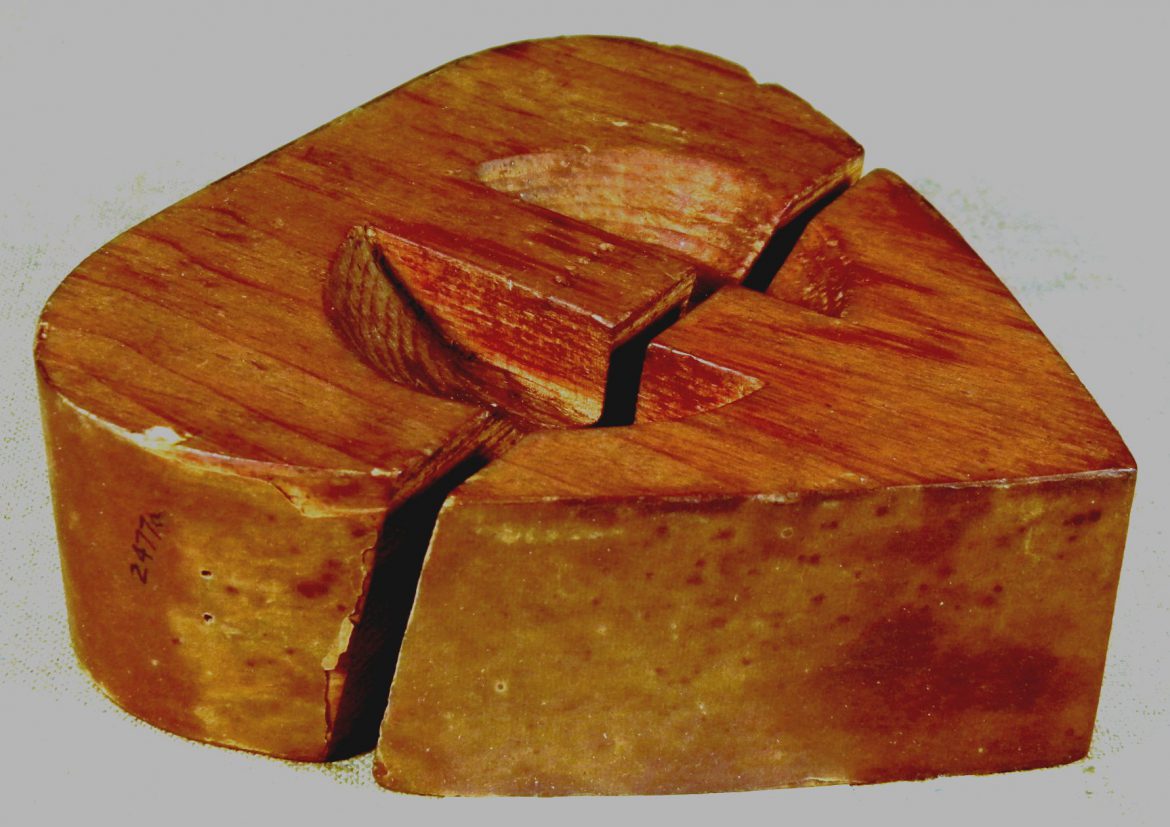
Heart-Shaped Form, Church Family, Mount Lebanon, NY, 1875-1900, Shaker Museum | Mount Lebanon: 1950.2477.1a,b.
The Shakers made poplar boxes of different shapes and styles in great numbers beginning in the 1860s and continuing in various communities for nearly a century. The first mention of “hearts” being made was in the Mount Lebanon Church Family deaconesses’ journals in 1873. Apparently they were not the most popular of the poplar products – often only three of […]

Heart-Shaped Woven Poplar Cloth Box, Church Family, Mount Lebanon, NY, 1875-1900, Shaker Museum | Mount Lebanon: 1993.2.20a,b.
The Shakers made poplar boxes of different shapes and styles in great numbers beginning in the 1860s and continuing in various communities for nearly a century. The first mention of “hearts” being made was in the Mount Lebanon Church Family deaconesses’ journals in 1873. Apparently they were not the most popular of the poplar products – often only three of four dozen were made in a given year. For many years Sister Emma J. Neale is noted as the maker of these particular poplar boxes. There are two types of forms on which these boxes were shaped. One was a solid piece of pine and the second, probably an improvement, was made in two parts joined at an angle so that when the larger part of the form was lifted the slightest amount, the form immediately became smaller keeping it from putting any stress on the recently glued sides of the box. The finishing – fitting a lid, adding any decoration, and sewing accouterments – completed the box for sale in the Office Store.

Heart-Shaped Form, Church Family, Mount Lebanon, NY, 1875-1900, Shaker Museum | Mount Lebanon: 1950.2477.1a,b.
Why did the Shakers at the Church Family at Mount Lebanon develop the heart-shaped product in the first place? It’s been suggested that the invention of poplar cloth and the poplarware products that followed was necessitated by a need to find a material to replace woven palm leaf when shipments of palm from Cuba and the Caribbean were halted by the beginning of the Civil War in April of 1861. The Shakers were prodigious consumers of palm leaf for manufacture of their bonnets – both for home use and for sale. While it may be the case that the Shakers were purchasing palm leaf from Cuba and the Caribbean, it continued to be available from Italy and Africa at the Port of Boston. In Barre, Worcester County, Massachusetts in 1865, there were more than 100 men and women employed in five businesses that made 328,000 palm leaf “Shaker hoods and hats or jockies.” These manufacturers were supplied by two businesses employing 19 men and women who processed over 250,000 pounds of green palm leaf into material for weaving and plaiting even during the Civil War. (Warner, Oliver. Statistical Information Relating to Certain Branches of Industry in Massachusetts for the Year Ending May 1, 1865. [Boston: The Commonwealth of Massachusetts, 1866]) To add to this apparent contradiction, Deaconess Betsy Crosman, recorded in her journal having “made 30 small popple [poplar] silk covered baskets for sale” at the beginning of November 1860. The next year she made 60 more and Deaconess Matilda Reed made 15 dozen napkin rings of popple cloth.” (“Deaconesses Journal, Church Family, Mount Lebanon, NY,” 1848-1872. Western Reserve Historical Society Library, Shaker Collection, mss. no., V:B-143.) Apparently by the time the insurrection had blossomed into a full-out war, the Shakers had already worked out the procedures and built the specialized machinery for manufacturing “popple cloth.”
Perhaps the switch from palm leaf to poplar was because the process of preparing palm leaf for weaving involved considerable work. The leaves were sorted, setting aside the longest leaves from which the warp “threads” were stripped out and gauged to the proper width. The shorter weft “threads” also had to be cut out and gauged. At some point these were dried and “bleached” in the fumes of burning sulfur to remove their green color. The warp was then tied on the loom (of course there were limitations on the length of the warp – and therefore the finished palm cloth – based on the length of the leaves). Finally, the weaving of the cloth could begin. With poplar, some of this tedious preparation was done by the brothers – at the very least, they planed the poplar into thin, consistently-sized strips. The gauging was done by machine and the poplar required no bleaching as its sap wood is naturally white. The greatest advantage of poplar over palm comes in the weaving. The thin strips of poplar are woven into a cotton warp and the length of the warp was not limited by the length of the poplar strips. In one case it was noted that the sisters put one hundred yards of warp on a loom for poplar cloth. In consideration of the advantages of poplar over palm leaf – yes, palm leaf may have been stronger and lasted longer, but unlike palm leaf bonnets, the products made from poplar were not expected to last for generations – it may have been that the idea to develop poplar cloth came as much from a desire to simplify and, by the way, use materials readily available on their own property at no cost but manpower.
A number of Shaker industries that seem simple and straightforward on first look, turn out to be quite complicated once investigated. Additional information and comments on the beginning of this important Shaker business are most welcome.